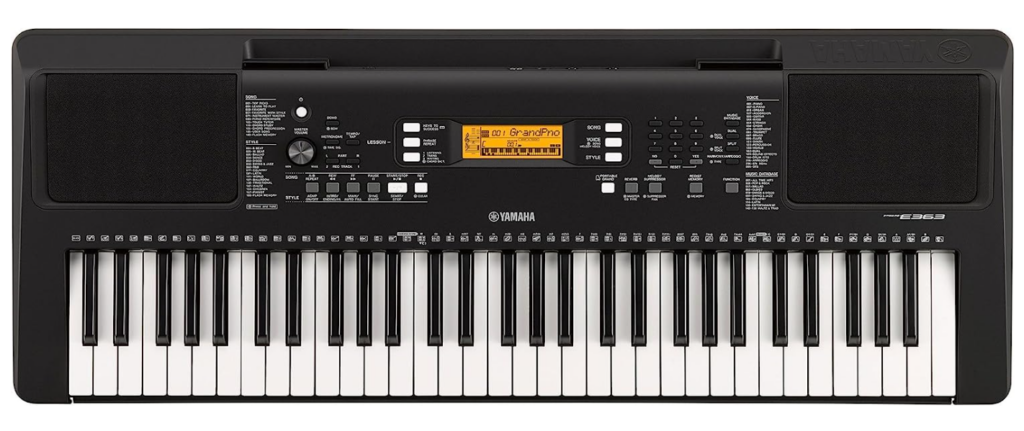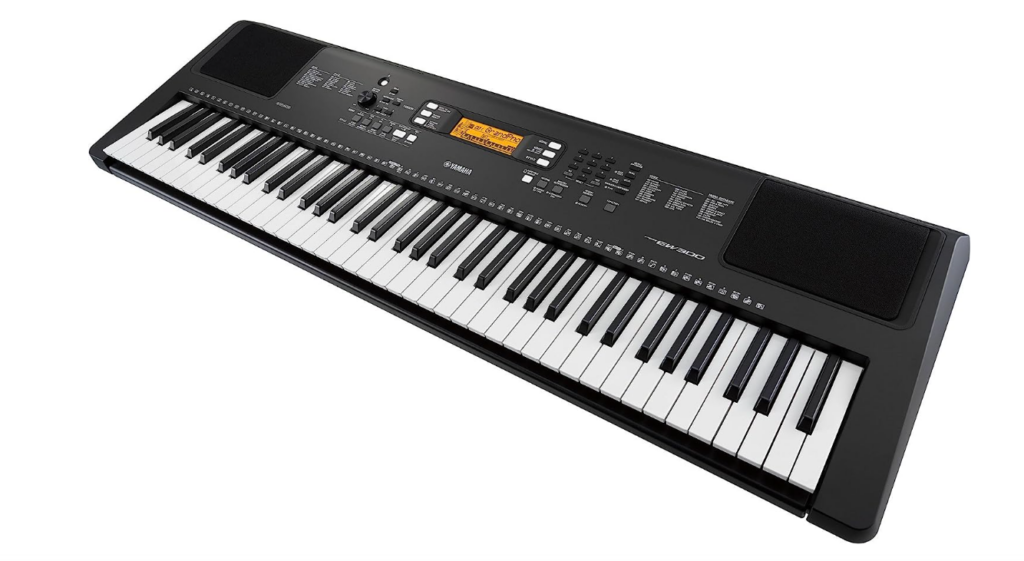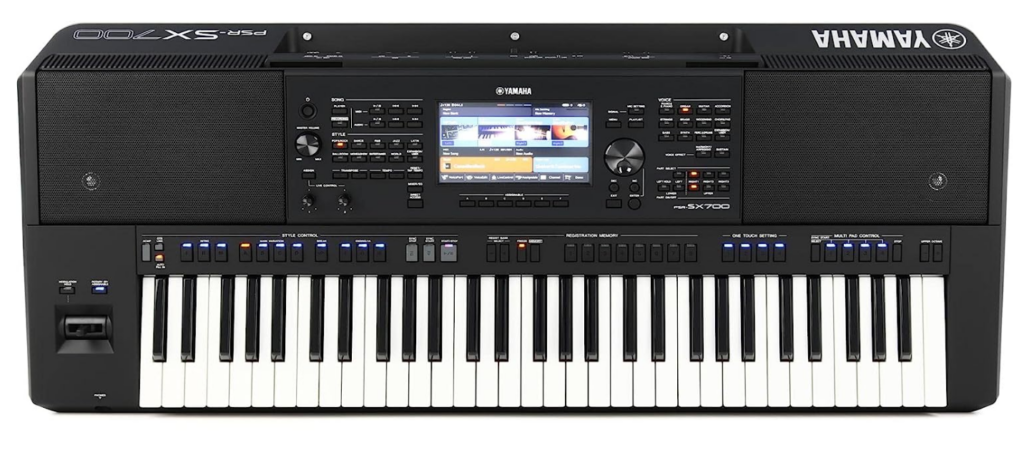In the music industry, Yamaha keyboards have long been associated with excellence, creativity, and versatility. Yamaha Corporation, which has a long history reaching back to the late 19th century, has made a name for itself as a top producer of musical instruments, including keyboards, pianos, and synthesizers. With their outstanding sound quality, cutting-edge features, and user-friendly design, Yamaha keyboards are well-liked by amateurs, enthusiasts, and professional musicians alike.
Authentic sound reproduction is a hallmark of Yamaha keyboards, which is made possible by the company’s rich background in the production of pianos. Yamaha keyboards’ use of digital sampling technology captures the subtleties of acoustic instruments, resulting in a realistic and expressive playing experience. Yamaha keyboards offer a huge collection of high-quality voices to pick from, ranging from grand pianos and electronic pianos to organs, synthesizers, and a wide variety of other instrument sounds.
With each new generation of keyboards, Yamaha has constantly advanced keyboard technology by adding new functions and improvements. Yamaha aims to make cutting-edge technology available to artists at various price points, from their flagship models to their more budget options. Yamaha keyboards are now recognized as being of the highest caliber in the music industry. Yamaha keyboards continue to excite musicians and push the boundaries of keyboard performance because to their great sound quality, flexible features, and dedication to innovation.
Yamaha PSR E363 Review
The Yamaha PSR-E363 is a flexible and reasonably priced keyboard that is suitable for both beginning and advanced players. This instrument delivers a satisfying playing experience at an affordable price range and is loaded with features and Yamaha’s famous sound quality. The PSR-E363’s large library of top-notch voices is one of its best qualities. You have a vast selection of alternatives to explore and experiment with thanks to the 574 instrument sounds, which include pianos, strings, guitars, drums, and more. With the help of Yamaha’s digital sampling technology, these voices will sound real and expressive, giving your performances more depth and authenticity.

| Features | Rating |
| Performance and sounds | 9.0 |
| Connectivity | 9.3 |
| Build quality | 8.9 |
| Value for money | 9.1 |
You can use the keyboard’s 165 auto accompaniment styles to play along with backing tracks in a variety of musical genres. As it gives your playing a sense of fullness and aids in the development of your sense of timing and rhythm, this feature is very beneficial for beginners. You can easily traverse the accompaniment
and adjust them to your tastes. Since the keyboard is lightweight and portable, it is suitable for both home usage and performance and is also simple to carry. The user-friendly interface has buttons that are clearly labeled and an LCD screen that makes it simple to access settings and functionalities. Despite having some drawbacks, the Yamaha PSR-E363 ultimately provides a superb playing experience.
The lack of weighted keys could be a drawback for pianists looking for a more authentic piano feel. Additionally, compared to keyboards with more keys, more experienced players could find the 61-key range to be restrictive. Additionally, the PSR-E363 has an integrated lesson function, which is a helpful feature for keyboard beginners. The Education Suite from Yamaha contains step-by-step instructions for everything from fundamental playing methods to more complex ones. A useful learning tool for beginners, the lesson mode divides songs into digestible chunks and offers feedback on your performance.
You Might Also Like: Yamaha MX49 Review
Specific Features
The Yamaha keyboard PSR e363 has some exceptional features that make it stand out amongst its competitors and those features are enlisted below:
- Touch-sensitive 61-key keyboard with 574 excellent instrument voices
- 165 types of auto-accompaniment
- Lesson function of the Yamaha Education Suite
- USB support for recording and MIDI
- Lightweight and transportable design
- LCD display for simple navigation
- Dual voice mode for sound layering
- 150 different varieties of onboard arpeggios and effects
- Using a pattern function to make loops
- AUX input for external audio device connection
- Phrase recorder for jotting down musical inspiration
- Tune and transposition adjustments
- Tempo and metronome adjustments
Check Out: Yamaha P45 Review
Pros
- It is inexpensive and adaptable, making it available to players at all skill levels.
- 574 high-quality instrument voices are available in a large library, providing a variety of aural options.
- 165 auto accompaniment styles are available for playing along with different kinds of backing recordings.
- Step-by-step instructions and feedback are provided via the lesson feature of the Yamaha Education Suite for learning and development.
- Expanding creative options is USB connectivity for MIDI communication and recording capabilities.
- Design that is portable and lightweight makes it ideal for performances both at home and on the go.
- An LCD screen with a user-friendly interface for quick navigation and function access.
- Using the dual voice mode, you can combine two sounds to produce performances that are richer and more dynamic.
- Players can enhance the depth and ambiance of their sound with the onboard effects and reverb.
Cons
- Weighted keys, which are common on more expensive keyboards and pianos, might offer more realism and touch sensitivity than non-weighted keys.
- A disadvantage for more experienced players who need a greater playing range is the keyboard’s small key count (61 keys), which is in comparison to keyboards with a larger range.
- The total sound quality may be constrained by the built-in speakers’ limited clarity and power compared to external speaker systems.
- Because of its small size and lack of illumination, the LCD screen may be difficult to read in some lighting situations.
- Limited memory for storing user modifications and settings.
- It is possible that the power adapter won’t be in the packaging and will have to be purchased separately.
- Comparing the overall build quality to higher-end Yamaha keyboard models, some users might feel it to be less durable.
- Advanced sound customization only offers a limited number of control choices and parameter changes.
- The keyboard might not have all the sophisticated features offered in more expensive models, like powerful music editing tools or cutting-edge connection possibilities.
- For more experienced players looking for more difficult and complex lessons, the learning system may feel constrained.
Also Check: Yamaha YDP-103 Review
Alternatives
Yamaha PSR EW300 Vs Yamaha PSR E363

The PSR-E363 is more portable than the PSR-EW300 since it is smaller and lighter. This makes it simpler to move around and better suited for musicians who frequently travel or want a portable keyboard. Compared to the PSR-EW300, the PSR-E363 is typically less expensive. The PSR-E363 offers a cost-effective solution without sacrificing necessary functions if money is an issue. Both keyboards contain touch-sensitive keys, allowing for expressive and dynamic playing. To ensure a responsive playing experience, the PSR-E363 has the same touch sensitivity as the PSR-EW300. Both keyboards have the Yamaha Education Suite lesson function, which offers feedback and step-by-step instructions to help with learning. The PSR-E363 thus provides a comparable learning experience to the PSR-EW300.
Controls and User Interface:
- PSR-E363: An LCD screen-based user interface
- PSR-EW300: An LCD screen-equipped user interface
Both keyboards include intuitive user interfaces and LCD panels for simple navigation and function access.
Connectivity:
- USB connection PSR-E363
- USB connectivity for the PSR-EW300
Both keyboards have USB ports for MIDI transmission and recording, which broadens the range of options for music production and software integration.
Sound System:
- Built-in speakers, PSR-E363
- Speakers built into the PSR-EW300
Both keyboards include built-in speakers that can emit sound right away.
Also Check: Yamaha DGX 650 Review
Yamaha PSR E273 Vs Yamaha PSR E363

Touch-sensitive keys on the PSR-E363 let you alter the sound’s expression and loudness by applying firm or gentle pressure to the keys. This improves your musical performance by enabling more dynamic and expressive playing. The PSR-E273 PKS, in comparison, lacks touch-sensitive keys, which restricts how expressive you may be. In comparison to the PSR-E273 PKS, which features 401 instrument voices, the PSR-E363 provides a bigger sound bank with 574 instrument voices. The PSR-E363’s wider variety of voices allows you more freedom and the ability to experiment with various musical genres and styles. 165 auto accompaniment styles are included with the PSR-E363, compared to 143 styles with the PSR-E273 PKS. An expanded range of backing tracks is offered by the PSR-E363.
Learning capabilities:
- Yamaha Education Suite lesson feature (PSR-E363)
- Yamaha Education Suite lesson function for the PSR-E273 PKS
The Yamaha Education Suite lesson feature is present on both keyboards, providing comparable learning capabilities.
Controls and User Interface:
- PSR-E363: An LCD screen-based user interface
- PSR-E273 PKS: An LCD screen-equipped user interface
Both keyboards include intuitive user interfaces and LCD panels for simple navigation and function access.
Connectivity:
- USB connection PSR-E363
- PKS for PSR-E273: USB connection
Both keyboards have USB interfaces for MIDI recording and communication.
Check More: Best Digital Pianos Under $1500
Yamaha PSREW310 Vs Yamaha PSR E363

The Yamaha PSR-E363 61-Key Touch Sensitive Portable Keyboard has a number of benefits over the Yamaha PSREW310 76-Key Touch Sensitive Portable Keyboard that make it an appealing option. Due to its reduced size and lighter weight, the PSR-E363 is extremely portable. It is made for musicians who are constantly on the move and makes it simple for them to carry and move the piano. The PSREW310, on the other hand, is bulkier and heavier, making it less practical for regular travel.
Second, the PSR-E363 offers a cost-effective alternative without sacrificing necessary features. Touch-sensitive keys are available, enabling expressive playing and dynamic sound control. This feature ensures that all keyboards have a comparable level of touch sensitivity because it is also featured in the PSREW310. A large sound library with 574 instrument sounds is another feature of the PSR-E363, offering a variety of opportunities for creative exploration. The PSREW310 has a little larger sound bank (622 instrument voices), but the PSR-E363 still has a wide range of sounds to suit various musical tastes.
Key range:
- PSR-E363 has a key range of 61 keys.
- Keys for PSREW310: 76
Compared to the PSR-E363, the PSREW310 features a broader key range with 76 keys, offering extra octaves and more performing possibilities.
Controls and User Interface:
- PSR-E363: An LCD screen-based user interface
- PSREW310: An LCD screen’s user-friendly interface
Both keyboards include LCD screens with user-friendly interfaces that provide comparable ease of use and control options.
Connectivity:
- PSR-E363 has a USB interface for connectivity.
- USB connection PSREW310
Both keyboards have USB interfaces for MIDI recording and communication.
Read More: Best Digital Pianos Under $700
Yamaha PSRSX700 Vs Yamaha PSR E363

Touch-sensitive keys on the PSR-E363 enable expressive playing and a more dynamic sound. Additionally, it has a built-in lesson function and a library of 574 instrument voices, giving students a wide range of practice and learning choices. It is a fantastic option for novices or those trying to develop their talents because of these qualities.
The LCD screen and user-friendly interface of the PSR-E363 make it simple to navigate and access several functions. It offers a simple and intuitive experience, especially for people who might be unfamiliar with keyboards or prefer a more simplistic layout. Despite being a professional-grade arranger workstation keyboard created for skilled artists, the Yamaha PSRSX700 has a premium price tag because of its rich feature set. A powerful sound engine, a sizable sound library, a variety of accompaniment styles, cutting-edge performance features, a larger color touch panel, and additional connectivity possibilities are all provided by the PSRSX700. Professionals, studio use, and live performances that call for advanced functionality and customization are all appropriate uses for it.
Controls and User Interface:
- PSR-E363: An LCD screen-based user interface
- PSRSX700: Larger color touch display and more sophisticated controls
Connectivity and Growth
- PSR-E363: Headphone output, AUX input, and USB connectivity
- PSRSX700: Numerous connecting choices and expansion options
Performance-related duties:
- PSR-E363: Basic performance features, constrained real-time control
- PSRSX700: extensive performance features, and real-time controls that can be assigned
Frequently Asked Questions (FAQs)
Is Yamaha PSR-E363 appropriate for beginners?
The Yamaha PSR-E363 is a fantastic choice for beginners, indeed. With touch-sensitive keys for expressive playing, a built-in lesson function to aid in learning, and a variety of instrument voices and accompaniment styles to experiment with and practice with, it is a great tool for musicians of all skill levels.
Is the Yamaha PSR-E363 USB-compatible?
In order to record, replay, and transmit data, you can connect the Yamaha PSR-E363 keyboard to a computer, MIDI equipment, or external storage.
Can I use the Yamaha PSR-E363 with headphones?
Yes, you can attach headphones to the Yamaha PSR-E363’s headphone output to practice or play in solitude without bothering others.
Can the Yamaha PSR-E363 be used to record performances?
Yes, you may record your performances right on the piano using the Yamaha PSR-E363’s built-in recording feature. Your recordings can be saved to the internal memory or externally by connecting a USB storage device.
Is there a power adaptor included with the Yamaha PSR-E363?
Yes, a power adaptor is normally provided with the Yamaha PSR-E363. To confirm the precise contents of the shipment, it is, nevertheless, best to contact the merchant or seller.
